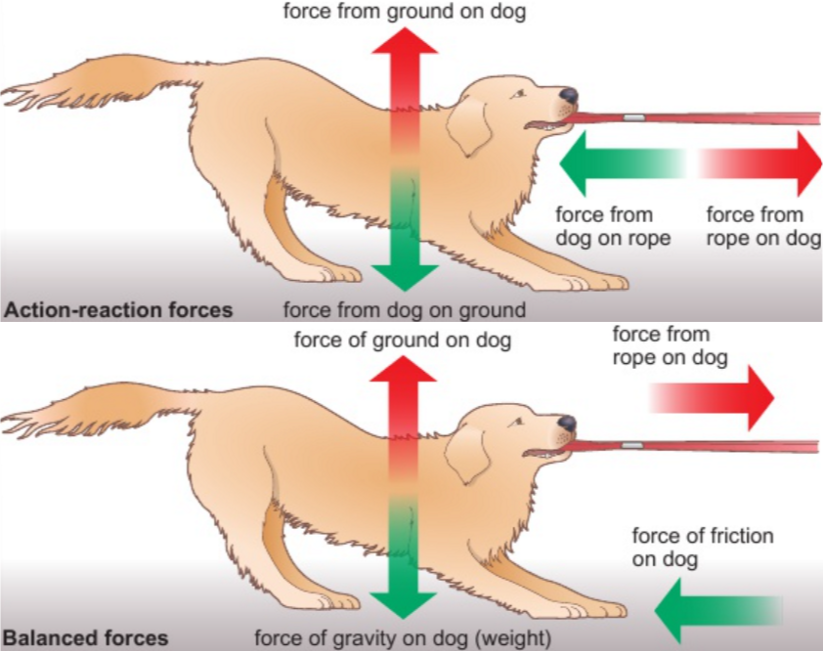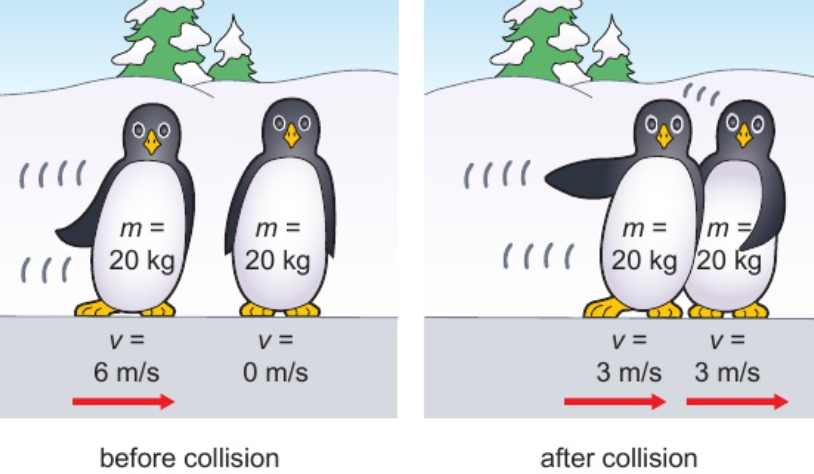physics - motion & forces (2.1 - 2.33)
1/53
There's no tags or description
Looks like no tags are added yet.
Name | Mastery | Learn | Test | Matching | Spaced |
|---|
No study sessions yet.
54 Terms
2.1 scalar quantities
magnitude (size)
no specific direction
2.2 vector quantities
magnitude (size)
specific direction
2.3 scalar vs vector quantities
scalar: only magnitude
vector: magnitude & direction
2.4 examples of scalar quantities
distance
speed
mass
energy
2.4 examples of vector quantities
displacement
velocity
acceleration
force
weight
momentum
2.5 velocity definition
speed in stated direction
2.6 speed equation
speed (m/s) = distance (m)/time (s)
s = d/t
2.7 distance/time graphs
horizontal line: object stationary
straight, sloping line: object travelling at constant speed
steeper line = object travelling faster
speed = gradient of line
gradient = Δy/Δx = d/t = s
2.8 acceleration equation
acceleration (m/ss) = change in velocity (m/s)/time (s)
a = (v-u)/t
2.9 (final velocity)2 - (initial velocity)2 equation
(final velocity)2 (m/s)2 - (initial velocity)2 (m/s)2 = 2 x acceleration (m/s2) x distance (m)
v2 - u2 = 2ax
2.10 velocity/time graphs
horizontal line: object travelling at constant velocity
negative velocity (below x axis): object moving in opposite direction
2.10 velocity/time graphs - compare acceleration from gradients
sloping line: object accelerating
steeper line = greater acceleration
line sloping down to right: object decelerating
2.10 velocity/time graphs - calculate acceleration from gradient
acceleration = gradient of line
gradient = Δy/Δx = (v-u)/t = a
2.10 velocity/time graphs - find distance travelled
distance travelled = area under graph
s x t = d
2.11 determining speed of objects using light gates
to measure speed - need distance & time
light gates measure time (more accurate than stopwatch)
2.12 typical everyday speeds
walking: 1.4 m/s
cycling: 6 m/s
speed limit in towns: 6 m/s
ferry: 18 m/s
motorway speed limit: 31 m/s
commuter train: 55 m/s
high speed train: 90 m/s
airliner: 250 m/s
2.13 acceleration in free fall
10 m/s2
2.14 Newton’s 1st law
moving object will continue to move at same speed & direction unless external force acts on it
stationary object will remain at rest unless external force acts on it
2.14 Newton’s 1st law - resultant force = 0
balanced forces = 0 resultant force
won’t change velocity of object
2.14 Newton’s 1st law - resultant force ≠ 0
unbalanced forces = non-0 resultant force
will change speed &/or direction of object
2.15 Newton’s 2nd law
acceleration of object directly proportional to force acting on it & inversely proportional to its mass
acceleration in direction of resultant force depends on:
size of force (same mass: bigger force = bigger acceleration)
mass of object (same force: bigger mass = smaller acceleration
2.15 force equation (Newton’s 2nd law)
force (N)= mass (kg) x acceleration (m/s2)
F = ma
2.16 weight definition
measure of pull of gravity on object
2.16 weight equation
weight (N) = mass (kg) x gravitational field strength (N/kg)
W = mg
2.17 how is weight measured?
using force meter - has scale in newtons
2.18 relationship between weight of body & grav. field strength
earth’s grav. field strength = 10 N/kg
each kg experiences force of 10N
2.19 core practical: relationship between force, mass & acceleration - how mass affects acceleration (masses on trolley)
prop up one end of ramp; place trolley on ramp
set up light gates & pulley & string
stick card to top of trolley; measure length of card
release trolley from top of ramp; record speed of trolley & time taken to go from 1st → 2nd light gate
put mass on trolley & repeat step 4
add mass to trolley; repeat step 5
2.19 core practical: relationship between force, mass & acceleration - how force affects acceleration (masses on trolley)
prop up one end of ramp; place trolley on ramp
set up light gates & pulley & string
stick card to top of trolley; measure length of card
add masses to trolley
release trolley from top of ramp; record speed of trolley & time taken to go from 1st → 2nd light gate
take 1 mass off trolley & put on end of string; repeat step 5
continue until all masses on trolley on end of string
2.20 object moving in circular orbit at constant speed
constant speed, changing velocity
moving at same speed, constantly changing direction
so accelerating (changing direction)
2.21 centripetal force
resultant force that acts towards centre of circle & causes change in direction (for object moving in circle)
2.22 inertial mass
measure of how difficult it is to change velocity of object
more massive object = need more force to change its velocity
inertial mass of object = force on it/acceleration force produces
2.23 Newton’s 3rd law
forces on 2 different objects when they interact with each other
objects can be touching (person & chair)/at distance (earth & moon)
for every action there is an equal & opposite reaction
2.23 Newton’s 3rd law - equilibrium situations
pair of forces on 2 interactive objects (action-reaction forces)
2 forces: same size, opposite directions
2.23 Newton’s 3rd law - collision interactions
action & reaction forces during collision:
same size
don’t necessarily have same effect - objects are diff. masses
2.23 Newton’s 3rd law - conservation of momentum
total momentum of both objects before collision = total momentum of both objects after collision
momentum lost by object 1 = momentum gained by object 2
momentum is conserved
2 objects moving opposite directions - 1 has positive & 1 has negative momentum
action-reaction forces vs balanced forces
action-reaction forces: act on different objects
balanced forces: act on same object

2.24 momentum definition
measure of tendency of object to keep moving/how hard it is to stop it moving
2.24 momentum equation
momentum (kg m/s) = mass (kg) x velocity (m/s)
p = mv
2.25 examples of momentum in collisions

2.26 force equation (Newton’s 2nd law)
force (N) = change in momentum (kg m/s)/time (s)
F = (mv - mu)/t
reaction time
time between person detecting stimulus & their response
2.27 methods of measuring human reaction times
computers, electric circuits - measure time between stimulus & response
2.27 typical results of human reaction times
visual stimulus - 0.25s
2.28 vehicle’s stopping distance
thinking distance + braking distance
2.29 factors affecting vehicle’s stopping distance
vehicle’s mass: more mass = more force to decelerate = greater s.d.
vehicle’s speed: greater speed = greater s.d.
driver’s reaction time: greater reaction time = greater s.d.
state of vehicle’s brakes: worn brakes = less friction = greater s.d.
state of road/amount of friction between tyre & road: wet road/loose gravel = less friction = greater s.d.
2.30 factors affecting driver’s reaction time
drugs/alcohol
tiredness
illness
distractions (e.g. phone)
2.31 dangers caused by large decelerations
large deceleration requires large force (on vehicle)
F = ma: a increases → f increases
2.31 forces in typical situations on public road
e.g. 1500kg car crashes at 15 m/s, stops in 1s
F = (mv - mu)/t
((1500 × 0) - (1500 × 15))/1
= -22500/1
= -22500N
2.32 stopping distances over range of speeds
20mph = 12m
30mph = 23m
40mph = 36m
50mph = 53m
60mph = 73m
70mph = 96m
work done definition
energy transferred by force acting over a distance
work done equation
work done (J) = force (N) x distance moved in direction of force (m)
E = Fd
kinetic energy definition
energy stored in moving object
kinetic energy equation
kinetic energy (J) = ½ x mass (kg) x speed2 (m/s)2
KE = ½mv2
2.33 braking distance, work done, kinetic energy
work done to stop vehicle = initial kinetic energy
braking distance depends on kinetic energy so depends on (initial velocity)2
e.g. velocity doubles → braking distance x 22 = 4